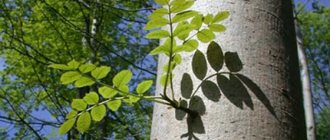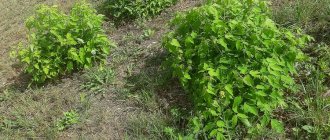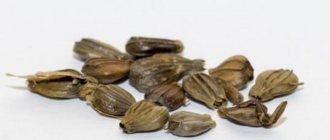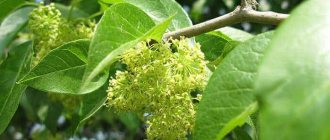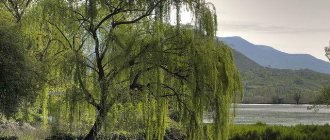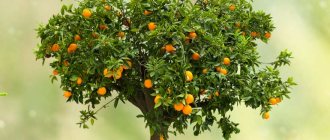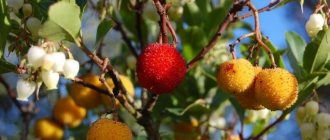Ash is considered the “tree of peace.” In the old days, it revived life and gave a person strength. Beads, amulets and runes were made from wood. The ash tree got its name due to its openwork crown. The tree transmits so much sunlight through its dense foliage that it is clear and always full of light underneath. You can verify this by looking at an ash tree. Where does this tree grow, what types of ash can be found in our country, descriptions and photos of different varieties - the secrets of the plant only on the Agronom.guru portal.
Tall and slender tree - ash
Ash - brief botanical information
Ash (Fraxinus) belongs to the Olive family and is translated from Latin as “ash”. The plant has a fibrous root system, the crown is oblong and spreading. In most varieties, the flowers are collected in snow-white inflorescences; in some species they can be purple or burgundy.
For good pollination it is necessary to plant several plants.
Ash flowers have no scent.
The bark of the tree is smooth and light gray in color. An adult plant can reach up to 30 m, but there are species that are giants, up to 60 m in height and 40 m in width. The crown is formed from flexible branches directed upward. The fruits of the tree are long, oblong in shape, on average 5 cm. They ripen in mid-autumn and last until the end of winter.
Lionfish are rounded at the bottom and have a small notch at the top.
All types of ash tolerate severe frosts well, love a lot of light and grow well in neutral-acidic, fertile soil. The tree lives up to 350 years, the first fruiting occurs at the age of 20 years.
Where is the best place to plant ash?
Ash is a unique plant. The tree not only withstands severe frosts and drought, but also copes excellently with smoke and gusty winds. Therefore, even if you plant a tree near the railway, it will develop well and delight everyone with its magnificent appearance.
Despite its resistance to climate change, the plant feels best in light and wind-protected areas. Also, special attention should be paid to the soil. It is best to plant a tree in nutritious soil.
Ash will not grow on sandy lands or those that are poor in useful microelements.
Distinctive features
Ash is used in almost all areas. It is used for the manufacture of:
- medicines;
- sports equipment;
- gun butt;
- paints;
- furniture;
- hives.
The wood of the tree is strong and silky, with a purple or pink tint. It has high viscosity and does not flake. The tree has one drawback - it is that the wood is quickly subject to wormhole, so everything made from ash must be treated with an antiseptic.
Many artists use the roots of the plant, which are very similar to the wood of the olive tree, to make various products and decorations. Ash fruits are also used in cooking; they are used to prepare salads and spices. Unripe fruits are pickled and added to meat dishes.
Usage
There is also a lot of information about the amazing properties of ash. Thanks to its unpretentiousness and its rapid growth, ash is a fairly valuable tree for creating parks and alleys, lining roads, and landscaping the city. Even in complex compositions it has an excellent appearance.
Products made from ash were durable and moderately heavy. Many types of weapons were made from it. These included war clubs, stakes with spears, bows, and even spears and arrows. It is not surprising that ancient people considered ash a symbol of war .
But peaceful people also found wide use for it. It was made from:
- rocker arms;
- sled;
- wheels;
- souvenirs;
- and small crafts.
Dishes made from this material were in great demand, the only decoration of which was the light and shiny texture of the wood itself. And even in shipbuilding, ash boards were known!
Nowadays, the functionality of this tree has expanded significantly:
- facing material;
- gymnastic bars;
- parquet;
- aircraft parts;
- items of sports equipment;
- oars;
- skis;
- tennis rocket;
- turning products and so on.
Car manufacturing, aircraft manufacturing and shipbuilding can hardly do without this valuable wood. Plywood and furniture, tool handles and stair railings are often made from ash.
Its fruits contain fatty oils that are used as food. The people of the Caucasus prepare them unripe with vinegar and salt. as a seasoning with meat or fish. And you can even preserve it by carefully chopping it first.
The seeds can be used to extract a dark green oil that is used to make paint, soap and artificial rubber.
Since the bark contains a lot of tannins, paint from it is usually brown, black or blue.
Medicinal properties of ash and traditional medicine
All parts of the plant are used for treatment: bark, leaves, fruits and roots, as they have diuretic, anti-inflammatory, hemostatic and laxative effects. The plant has also found use in folk medicine for the treatment of radiculitis, cough and rapid healing of wounds.
Several proven recipes from ash:
- To prevent the wound from becoming inflamed and heal quickly, you need to chop the leaves and bark, apply it to the wound and change the bandage 2-3 times a day.
- For radiculitis, a decoction is made: 25 g of dry leaves are poured with 250 ml of boiling water. Let it brew for about half an hour. The prepared decoction is drunk three times a day, 50 ml.
- For bronchitis, a tincture is made: 35 g of dry leaves are poured into 0.5 liters of boiling water. Let it brew, strain and drink 100 ml three times a day.
- To increase immunity, drink 100 ml of tincture from the root for 14 days.
A tree that is valued not only for its beauty
Types of ash
Ash is the most numerous and popular species of the Olive family. There are more than 50 species, mostly deciduous trees, but there are varieties in the form of shrubs.
Pennsylvanian
Pennsylvania ash, or downy ash, grows up to 25 m in height. Young branches are felty and covered with dark brown bark. The leaf blade is imparipinnate, consists of 9 leaves of a dark olive color, which by autumn do not change their color and turn green. The inflorescences are pale green, without aroma.
The species is fast growing, gaining about 50 cm in height and 30 cm in width per year. Lives up to 350 years. Ash grows in fertile soil and a sunny place. Although the variety is frost-resistant, it is not recommended to grow it in the northern regions.
The plant prefers moisture and therefore needs regular watering.
Ordinary
Common or tall ash (Fraxinus excelsior) reaches considerable sizes. There are quite massive samples - 40 m. The bark is colored gray-green, which with age becomes ashen in color and becomes covered with cracks.
From the buds, odd-pinnate leaves of light green color are formed. Snow-white inflorescences appear in early spring before foliage. After flowering, fruits are formed - lionfish, reaching a length of up to 5 cm. The fruits have a light olive color, turn brown and begin to ripen in the fall. They can stay on the shoots all winter.
European countries and Transcaucasia are considered the homeland of high ash. Grows on fertile, slightly alkaline soil. In the southern regions of Russia, ash is grown as an ornamental plant to decorate a personal plot.
Common ash has a high and openwork crown
Manchurian
As you can easily guess from the name, this species came to our country from Manchuria, China, Japan and Korea. Grows in forests, on nutritious soil, next to Japanese elm and Maksimovich poplar. The centenarian grows up to 350 years.
The tree is dioecious and when flowering is covered with flowers of different sexes. The variety has an erect trunk, from which the branches diverge obliquely. It reaches a height of up to 35 m, and a diameter of up to 15 m.
Manchurian ash has a specific shape and type of leaf
The bark is brown or ash-colored and has small cracks and longitudinal ribs up to 5 cm thick. Flowering begins in May and continues until September. In place of flowers, fruits appear - lionfish, which last until spring. At the ripening stage they are olive-colored.
Flat lionfish acquire a brown tint towards the end of ripening
Chinese
Chinese ash, or ailanthus, is a light-loving palm-shaped plant native to Northern China. It grows throughout Russia and is widely used for landscaping populated areas. The trunk is gray-brown in color with a furrowed structure of thin bark. The leaves are large, very similar to palm trees, reaching a length of up to 60 cm. Yellow-green flowers are collected in large panicle inflorescences. Flowering begins in mid-summer. After the flowers, small red-brown fruits are formed, which stand out against the background of olive foliage.
Ash flowers emit a not entirely pleasant aroma
This type of ash is fast-growing; by the age of five years the tree reaches 5 m. Chinese ash, or the tree of the Gods, loves a lot of light and warmth. At a young age, the plant is not frost-resistant, but the frozen crown is well restored due to the rapid growth of young shoots. Thanks to its powerful roots, the plant can grow in an open, windy area.
In medicine, due to the rich chemical composition, leaves, bark, flowers and fruits are used. Fresh bark treats dysentery, flowers and foliage treat scarlet fever and diphtheria, and the fruits are prescribed for diseases of the genitourinary system. The leaves have antiviral and antimicrobial properties. The leaves are used to make decoctions that are taken to treat fever.
The bark and leaves have irritating properties; when collecting raw materials, a pustular or blistering rash may appear.
Chinese ash is unpretentious to grow and grows well in moist loamy soil.
American
A slender, tall tree with an ovoid-shaped crown. The leaf is complex and quite large, reaching up to 30 cm in length, consisting of 5-9 leaf plates. American ash blooms in the first half of spring, before young leaves appear. Fruiting begins at the end of summer. The fruits are rich in fats, so birds love them very much, and people use them in cooking. It begins to bear fruit from 25 to 40 years of age. The species is unpretentious and grows on slightly acidic fertile soil. Does not tolerate dry weather well. In its natural growing conditions it can be found next to oak, alder and maple. Widely used in folk medicine. The bark and leaves are used to treat radiculitis, the seeds treat cough, dropsy and liver diseases.
One of the most revered trees in the Caucasus
Black
Black ash, or brown, is relatively small in size compared to other representatives of this family - no more than 20 m in height. The species is widespread in North America, grows in marshy lands and along river banks, therefore, it is not afraid of stagnant water in the soil.
The plant is frost-resistant and does not produce inflorescences. By the age of five, the tree grows up to 2 m. The leaf is complex, consists of 5-10 leaf blades of bright olive color.
Ash is valued for its beauty, therefore it is widely used in landscape decoration
Ash - all about clear wood
Its Russian name is associated with the word “clear” and this name is well deserved. Weaker plants settle under its sun-permeable crown. And in light shade, under protection, many species develop faster.
Ash (lat. Fraxinus) is a genus of valuable woody plants of the Olive family. Its representatives are deciduous, and some subtropical species are evergreen flowering plants, found in the Northern Hemisphere of the Earth. They are found on the continents of Eurasia and North America. One species of ash grows in northern Africa. The genus includes 65 species. In Russia, 5 of them are most common (common, Pennsylvania, American, Manchurian and lanceolate).
How to recognize ash?
This is a tree with a straight trunk 25-60 m tall, rarely a shrub, with an openwork rounded crown. bark is soft, pubescent, gray with thin cracks at the bottom of the trunk. Young shoots are yellowish-green.
The wood is strong, dense, creamy white or light brown. It is spoiled by the soft, rotting core.
Ash has a powerful root system . It holds soil particles together well, so the plant is used for land reclamation. But in different environmental conditions it is not the same. With a lack of moisture and deep groundwater, the ash tree develops main, powerful lateral and adventitious roots. At the same time, the root system occupies both vertical and horizontal sections of the soil in order to more fully use the water that gets into it. If groundwater is located close, then the tree develops an anchor (surface) root system, in which it is very difficult to isolate the main root.
Ash leaves are arranged oppositely, less often whorled - in groups of 3. They are imparipinnately compound, there are no more than 2 pairs of lateral segments, and there is always an unpaired apical leaflet. In total, there are from 7 to 15 sessile or petiolate leaf blades on one axis.
Some species have simple leaves. The plates are always thin, dark green, turning yellow in autumn.
Ash is a monoecious plant , less often dioecious, blooms before the leaves bloom. It has bisexual or heterosexual flowers, panicles collected in inflorescences; female flowers are longer, petalless, sometimes purple, male flowers are dark brown. Most ash trees have greenish flowers, but there are species with white lush inflorescences. In dioecious taxa, sex can change; pistillate flowers appear on the tree one year, and staminate flowers the next. Stamens and pistils in flowers are often underdeveloped. There are usually 2 stamens in flowers, less often there may be 1 or 3. Pollen is carried by wind and insects. Cross pollination means that pistillate and staminate flowers that bloom on the same tree do not ripen at the same time. During this time, ash pollen often causes contact dermatitis in humans.
The fruit is a winged single-seeded nut. Lanceolate or oblong-elliptical, 350-450 mm long. It is concave, resembling a propeller blade. The structure of the fruit is an important systematic feature of ash. To determine the species, you need to study how its “wing” is located relative to the fruit and seed. In American ash, the wing is apical; in green and Pennsylvania ash, it is located on the side of the fruit.
Fatty, protein-rich and tannin-free ash fruits are loved by many animals: birds, rodents, and in North America, frog tadpoles feed on lionfish that have fallen into water bodies.
Popular types of ash
Common or tall ash
Tree up to 30 m high. Distinguished by velvety black buds.
Leaves with 7-11 lanceolate or elliptical leaflets. The plant is monoecious; both staminate and bisexual flowers bloom on it in April-May. The fruits are elongated, elliptical, rounded at the apex, winged almost to the base, usually twisted. They ripen from August until next spring; their maximum fall is observed in December.
Common ash grows in deciduous forests. Its wood has valuable characteristics and is used in industry and woodworking.
In the European part of Russia, only pedunculate oak wood is valued higher than it.
Ash tree – photo and description
Ash is a deciduous tree with a light, clear crown. A mature tree reaches up to 40 m in height and 1.5 m in diameter. It is easily recognized by its slender trunk, covered with dark gray bark with small cracks. Ash wood is used to make furniture fronts. Thanks to its transparent crown, the tree is used for landscaping garden plots and city parks and squares. The tree's root system is located close to the surface.
Ash is unpretentious and can grow in any soil, but most of all it prefers fertile soil with medium acidity. Most species lack a taproot. If ash grows in arid regions, the tree grows a tap root and forms horizontal shoots. There are species that can independently water themselves, obtaining water from a depth of 3 m.
Deciduous tree with a slender beautiful trunk
Ash seeds - photo and description
Ash seeds are lionfish that appear in early fall. They reach a length of up to 5 cm and have a dark olive color, gradually turning into brown. The seeds are used to make oil, which is later used to make soap and paint. The seeds are also widely used in folk medicine.
Ash is a poisonous plant, and its use as a medicine must be strictly under the supervision of a doctor.
Ash seeds can germinate in unexpected places, so the tree can become an uninvited guest in your garden.
Seed collection for the winter is carried out at the end of autumn
Ash leaves - photo and description
The leaves of the tree are opposite and begin to bloom after the ash tree blooms. The leaf blades alternate crosswise. One cutting grows up to 15 small dark green leaves.
The leaves rarely turn yellow, and the tree sheds them green
Fruits - photo and description
The fruits are ovoid in shape, about 5 cm in size. Inside the lionfish there is an oval-shaped nut. The fruits may remain on the tree until mid-winter or early spring. In many species they are edible and contain large amounts of fat and protein. Green fruits are pickled for the winter and used as a seasoning for meat; in some countries they are added to national dishes.
Ash fruits remain on the tree all winter
Description of the tree
To know what we are talking about, you need to understand what an ash tree looks like. It is extremely beautiful, first of all, thanks to its leaves, which are so thin and delicate that you can see the sun's rays through them. Light penetrates through the leaf, which is why the tree has such a cute name. According to Dahl's dictionary, the word “ash” comes from “light, clear.”
Ash is a deciduous tree, so it changes its leaves every year. In general, there are about 60 species of this plant in the world, the largest of which is white ash. This is a very powerful tree. Its leaves resemble bird feathers with a symmetrical structure.
The ash tree blooms its flowers even earlier than its leaves. Dark brown or purple flowers are collected in bunches of several pieces. Most often they do not have a corolla and a calyx, but they do have several stamens, which are a distinctive feature of the tree.
It’s better to see once than to hear many times, so it’s worth taking a close look at the photographs, which will show better than any words what ash really is.
How many years does an ash tree live?
The average lifespan of a tree is about 100 years. There are long-lived species, their age can reach 350 years. Single specimens that grow in fertile soil and a sunny place “live” the longest. Ash trees growing in dense forests quickly die due to lack of light.
Ash is best grown in a sunny location.
When the ash tree blooms
Flowering occurs in early spring. Both female and male flowers bloom on the tree, which have paniculate inflorescences in the form of thin fluff of snow-white, yellowish or purple color. Female flowers are pollinated from neighboring trees, since male flowers appear much later. Due to its lack of aroma, the tree rarely attracts insects.
Flowers lack perianth
The Tale of Ash
A TALE ABOUT ASH. Did you know that there are a considerable number of “magical” plants in the plant world? If you take a little break from the everyday world and plunge into the world of fairy tales and fantasies, then in magical gardens you can find many magical herbs, plants, and sacred trees. There is such a science - ethnobotany. She studies folk tales, legends and tales about plants. Many interesting facts about “magical” plants can be discovered by remembering the history of botany itself. And we all love fairy tales and wonderful stories - funny or scary. For example, my fairy tale about Ash.
Once upon a time there lived Yasen. Many birds flew past him, many people and animals walked. All the animals and plants loved this tree very much and often came up to it: sometimes just to admire it, and sometimes to store fruits for the winter.. Then one day a titmouse flies to the Ash tree and asks him:
- Why do they call you Ash? - the Tit flew in and asked the tree. “Look and think,” answered Ash. The bird looked carefully at the trunk of the tree, at its branches and yellow leaves, consisting of several small leaves. At this time, the autumn sun came out from behind the clouds and illuminated the Ash Tree. Its yellow leaves seemed to burst into flames. Bright, cheerful, clear. “I guessed it, I guessed it!” the yellow-breasted one was delighted. “They called you that for your beauty and festive radiance.” “Peep-pee-pee,” squeaked the mice that came running to the Ash Tree and asked the Titmouse: “Pluck it for us, please.” fruit. Both birds and we love these lionfish very much. The tit began to tear off with its beak the seeds that looked like a bunch of keys and threw them down. “Thank you,” thanked the small gray animals with long tails. “Don’t thank me, but Ash.” These are his lionfish.
The tree shook its branches: “Eat for your health, and store my fruits for the winter.”
This tree probably has a lot to do with it. For example, our village Yesenovichi was named that way because there was a monastery not far from the village of Andreevo. One day a monk escaped from this monastery, taking with him the monastic valuables. When the abbot organized a pursuit of the fugitive, the monk hid in the hollow of the Ash oak tree. The monk hung his clothes and cross on this tree, and disappeared. To compensate for losses, a wooden church (chapel) of the Savior was built on the site, near Yasen, and the place was declared holy. Gradually, people began to settle near the church and the settlement was named Spas-Yasenovichi. But later they renamed it Yesenovichi, as it is still called today.
Author of the work: Belova Natalya, age 11 years
I live at the address
Yesenovichi village, Gogol street. building 9.
Rules for planting ash trees
Ash is planted to strengthen slopes and ravines. Thanks to the root system, the tree keeps the soil from crumbling and helps protect it from drying out. In landscape decoration, the plant is planted in personal plots.
If ash is grown on a plot, then it is necessary to choose varieties that do not form dense shade.
It is better to plant ash seedlings in an open area and in fertile, slightly acidic soil. For planting, dig a hole that should be twice the size of the root system. Inside we place drainage, sand and ¼ moistened soil. We install the seedling and carefully cover it with soil, making sure that no air cushion is formed.
After planting, the soil is compacted and mulched. If several seedlings are planted, it is necessary to maintain a distance of at least 5 m from each other. In order for the tree to grow slender, young seedlings are tied to pegs on both sides.
In the first five years of life, the tree must be insulated for the winter.
How to grow ash: seed method
Growing a tree from grains is quite simple. For this you can use both last year’s and fresh planting material.
Seeds are planted at the end of summer. At this time, the grains will be able to germinate quickly and begin to develop rapidly. Autumn and spring planting will not give the desired result.
The sown ash seeds must be covered for the winter. For this purpose, special agrofibre is used.
Ash should only be sown in previously prepared furrows. They should be located at a depth of about 5 cm. The approximate consumption of planting material is 8 g per 1 m2. It is not necessary to fertilize the soil. Thoroughly cover the recesses with soil and compact them lightly. Drizzle generously over top.
If everything is done correctly, the first shoots will appear in mid-May.
Caring for seedlings is quite simple. In order for them to grow quickly and be beautiful, they must be systematically watered. Take water only at room temperature and settled. There should be no impurities in the liquid.
Also, do not forget about loosening the soil. This is an important condition in caring for young ash trees. The soil should be loosened 4 to 6 times throughout the entire summer season.
Care and disease control
If the place for planting an ash tree is chosen correctly, the tree can grow up to 40 cm in height in the first year. In spring and autumn, ash needs feeding. Both organic and mineral fertilizers are suitable for this.
The tree will only need watering in hot summers. The pest very rarely settles on ash trees. If a bark beetle or ash bark beetle is detected, it is treated with insecticides.
With good care, ash will be an excellent addition to landscape design.
Applications of ash for various purposes
Ash is a tree that can be used both in industry and for making medicine:
- Blue, black and brown paint is made from the bark and leaves. Fresh leaves are used to feed livestock.
- Buds, bark, roots, leaves and flowers are used to prepare infusions, decoctions and liqueurs.
- Unripe fruits are pickled. Young fruits after pickling acquire the taste of pickled walnuts. In the Caucasus, they are added to meat dishes as a hot spice. In European countries they are used in the preparation of vinegar. They complement meat and vegetables well due to their spicy taste and aroma.
- Since wood has high physical and mechanical properties, it is used to make furniture, veneer, beehives, sports equipment and propellers for light aircraft.
- Sculptors make unforgettable figures from ash stumps, and artists paint fantastic pictures on the bark.
- In landscape decor. Ash is used for alley and single planting, as well as near a pond.
Ash - the tree from which God created man
Interesting Facts
- Ash in common people has several names: holly, ash, ash. In nature it often grows next to oak trees. By watching the trees, you could find out what kind of summer it would be like. If the oak tree shows its leaves first, it means it will be hot and dry.
- The Greeks used the juice of the plant for snake bites.
- In Rus', the bark of the tree was used as a remedy for malaria and fever.
- In magic, ash personifies good and evil; it has powerful energy.
- Many peoples worshiped the tree. It was called the “tree of knowledge” and was considered a symbol of life and wisdom.
We will be very pleased if the reader discovered new and interesting facts about ash in this article. If something was unclear, you can ask questions in the comments below. Our editors will be happy to answer all readers.
You can find out what ash looks like from the video provided:
X
